Regulation of luminal acidification in the male reproductive tract via cell-cell crosstalk
- PMID: 19448084
- PMCID: PMC2683015
- DOI: 10.1242/jeb.027284
Regulation of luminal acidification in the male reproductive tract via cell-cell crosstalk
Abstract
In the epididymis, spermatozoa acquire their ability to become motile and to fertilize an egg. A luminal acidic pH and a low bicarbonate concentration help keep spermatozoa in a quiescent state during their maturation and storage in this organ. Net proton secretion is crucial to maintain the acidity of the luminal fluid in the epididymis. A sub-population of epithelial cells, the clear cells, express high levels of the proton-pumping V-ATPase in their apical membrane and are important contributors to luminal acidification. This review describes selected aspects of V-ATPase regulation in clear cells. The assembly of a particular set of V-ATPase subunit isoforms governs the targeting of the pump to the apical plasma membrane. Regulation of V-ATPase-dependent proton secretion occurs via recycling mechanisms. The bicarbonate-activated adenylyl cyclase is involved in the non-hormonal regulation of V-ATPase recycling, following activation of bicarbonate secretion by principal cells. The V-ATPase is also regulated in a paracrine manner by luminal angiotensin II by activation of the angiotensin II type 2 receptor (AGTR2), which is located in basal cells. Basal cells have the remarkable property of extending long and slender cytoplasmic projections that cross the tight junction barrier to monitor the luminal environment. Clear cells are activated by a nitric oxide signal that originates from basal cells. Thus, a complex interplay between the different cell types present in the epithelium leads to activation of the luminal acidifying capacity of the epididymis, a process that is crucial for sperm maturation and storage.
Figures

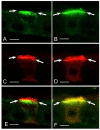
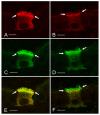
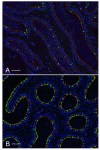

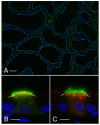

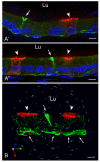
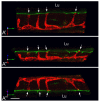


Similar articles
-
Establishment of cell-cell cross talk in the epididymis: control of luminal acidification.J Androl. 2011 Nov-Dec;32(6):576-86. doi: 10.2164/jandrol.111.012971. Epub 2011 Mar 25. J Androl. 2011. PMID: 21441423 Free PMC article. Review.
-
Unravelling purinergic regulation in the epididymis: activation of V-ATPase-dependent acidification by luminal ATP and adenosine.J Physiol. 2019 Apr;597(7):1957-1973. doi: 10.1113/JP277565. Epub 2019 Feb 28. J Physiol. 2019. PMID: 30746715 Free PMC article.
-
Modulation of the actin cytoskeleton via gelsolin regulates vacuolar H+-ATPase recycling.J Biol Chem. 2005 Mar 4;280(9):8452-63. doi: 10.1074/jbc.M412750200. Epub 2004 Dec 9. J Biol Chem. 2005. PMID: 15591047
-
Alkaline pH- and cAMP-induced V-ATPase membrane accumulation is mediated by protein kinase A in epididymal clear cells.Am J Physiol Cell Physiol. 2008 Feb;294(2):C488-94. doi: 10.1152/ajpcell.00537.2007. Epub 2007 Dec 26. Am J Physiol Cell Physiol. 2008. PMID: 18160485 Free PMC article.
-
Regulation of vacuolar proton pumping ATPase-dependent luminal acidification in the epididymis.Asian J Androl. 2007 Jul;9(4):476-82. doi: 10.1111/j.1745-7262.2007.00299.x. Asian J Androl. 2007. PMID: 17589784 Review.
Cited by
-
Structural analysis of the N-terminal domain of subunit a of the yeast vacuolar ATPase (V-ATPase) using accessibility of single cysteine substitutions to chemical modification.J Biol Chem. 2013 Aug 2;288(31):22798-808. doi: 10.1074/jbc.M113.460295. Epub 2013 Jun 5. J Biol Chem. 2013. PMID: 23740254 Free PMC article.
-
Large-scale phenotyping of an accurate genetic mouse model of JNCL identifies novel early pathology outside the central nervous system.PLoS One. 2012;7(6):e38310. doi: 10.1371/journal.pone.0038310. Epub 2012 Jun 6. PLoS One. 2012. PMID: 22701626 Free PMC article.
-
Analysis of Epididymal Protein Synthesis and Secretion.J Vis Exp. 2018 Aug 25;(138):58308. doi: 10.3791/58308. J Vis Exp. 2018. PMID: 30199011 Free PMC article.
-
Morphology and immunolocalization of aquaporins 1 and 9 in the agouti (Dasyprocta azarae) testis excurrent ducts.Anim Reprod. 2021 Nov 4;18(3):e20210070. doi: 10.1590/1984-3143-AR2021-0070. eCollection 2021. Anim Reprod. 2021. PMID: 34840612 Free PMC article.
-
ATP secretion in the male reproductive tract: essential role of CFTR.J Physiol. 2012 Sep 1;590(17):4209-22. doi: 10.1113/jphysiol.2012.230581. Epub 2012 Jun 18. J Physiol. 2012. PMID: 22711960 Free PMC article.
References
-
- Acott, T. S. and Carr, D. W. (1984). Inhibition of bovine spermatozoa by caudal epididymal fluid: II. Interaction of pH and a quiescence factor. Biol. Reprod. 30, 926-935. - PubMed
-
- Bagnis, C., Marsolais, M., Biemesderfer, D., Laprade, R. and Breton, S. (2001). Na(+)/H(+)-exchange activity and immunolocalization of NHE3 in rat epididymis. Am. J. Physiol. Renal Physiol. 280, F426-F436. - PubMed
-
- Beaulieu, V., Da Silva, N., Pastor-Soler, N., Brown, C. R., Smith, P. J., Brown, D. and Breton, S. (2005). Modulation of the actin cytoskeleton via gelsolin regulates vacuolar H+ATPase (V-ATPase) recycling. J. Biol. Chem. 280, 8452-8463. - PubMed
-
- Beyenbach, K. W. and Wieczorek, H. (2006). The V-type H+ ATPase: molecular structure and function, physiological roles and regulation. J. Exp. Biol. 209, 577-589. - PubMed
Publication types
MeSH terms
Substances
Grants and funding
LinkOut - more resources
Full Text Sources

